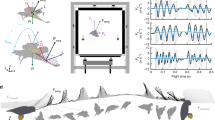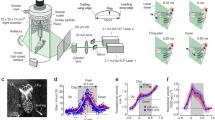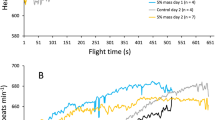Abstract
AERODYNAMIC theories predict that the mechanical power required for flapping animal flight varies with flight speed according to a 'U-shaped' curve1–6. At some intermediate speed there is a pronounced power minimum, typically half the power required for hovering flight. These theories are widely used for birds and bats, but the predictions are not well supported by measurements of the rate of energy expenditure, or metabolic rate—usually determined from the rate of oxygen consumption—of animals flying in wind tunnels. This rate follows a distinctly U-shaped curve in a few species, but quantitative agreement with theoretical predictions is nevertheless unsatisfactory7–9. In other species either the curve is much flattened or the rate shows no significant change with flight speed10–13. In one case the agreement between theory and experiment is remarkable over the limited speed range under test6,14, but there is a discrepancy in the shapes of the two curves which would lead to large differences outside that speed range. Hummingbirds show no significant difference in their flight metabolism over speeds from hovering up to 7 m s−1 (ref. 15). At even higher speeds the metabolic rate increases, presumably as a result of the increased power needed to overcome body drag. The theories can also be applied to insects, but there are no equivalent data against which they can be tested. Here we report such measurements for bumblebees in free, controlled, forward flight over a speed range of 0–4 m s−1. The metabolic rate does not vary significantly with flight speed, suggesting that the theories are inadequate for insect flight.
This is a preview of subscription content, access via your institution
Access options
Subscribe to this journal
Receive 51 print issues and online access
$199.00 per year
only $3.90 per issue
Buy this article
- Purchase on Springer Link
- Instant access to full article PDF
Prices may be subject to local taxes which are calculated during checkout
Similar content being viewed by others
References
Pennycuick, C. J. Ibis. 111, 525–556 (1969).
Tucker, V. A. J. exp. Biol. 58, 689–709 (1973).
Pennycuick, C. J. in Avian Biology (eds Farner, D. S. & King, J. R.) Vol. 5, 1–75 (Academic, London, 1975).
Greenewalt, C. H. Trans. Am. phil. Soc. 65(4), 1–67 (1975).
Rayner, J. M. V. J. exp. Biol. 80, 17–54 (1979).
Pennycuick, C. J. Bird Flight Performance. A Practical Calculation Manual (University Press, Oxford, 1989).
Tucker, V. A. J. exp. Biol. 48, 67–87 (1968)
Thomas, S. P. J. exp. Biol. 63, 273–293 (1975).
Carpenter, R. E. J. exp. Biol. 114, 619–647 (1985).
Tucker, V. A. Am. J. Physiol. 222, 237–245 (1972).
Bernstein, M. H., Thomas, S. P. & Schmidt Neilsen, K. J. exp. Biol. 58, 401–410 (1973).
Torre-Bueno, J. R. & LaRochelle, J. J. exp. Biol. 75, 223–229 (1977).
Hudson, D. M. & Bernstein, M. H. J. exp. Biol. 103, 121–130 (1983).
Rothe, H.-J., Biesel, W. & Nachtigall, W. J. comp. Physiol. B 157, 99–109 (1987).
Berger, M. in BIONA Report 3 (ed. Nachtigall, W.) 307–314 (G. Fisher, Mainz, 1985).
Kammer, A. E. & Heinrich, B. Adv. Insect Physiol. 13, 133–228 (1978).
Nachtigall, W., Rothe, U., Feller, P. & Jungmann, R. J. comp. Physiol. B 158, 729–737 (1989).
Armstrong, G. & Mordue, W. Physiol. Ent. 10, 353–358 (1985).
Demoll, R. Der Flug der Insekten und der Vögel (Fischer, Jena, 1918).
Dudley, R. & Ellington, C. P. J. exp. Biol. 148, 53–88 (1990).
Berger, M. & Hart, J. S. J. comp. Physiol. 81, 363–380 (1972).
Berger, M. J. Orn., Lpz. 115, 273–288 (1974).
Casey, T. M. in Insect Flight (eds Goldsworthy, G. & Wheeler, C.) 257–272 (CRC, Boca Raton, 1989).
Heinrich, B. J. comp. Physiol. 96, 155–166 (1975).
Wolf, Th. J., Schmid-Hempel, P., Ellington, C. P. & Stevenson, R. D. Funct. Ecol. 3, 417–424 (1989).
Author information
Authors and Affiliations
Rights and permissions
About this article
Cite this article
Ellington, C., Machin, K. & Casey, T. Oxygen consumption of bumblebees in forward flight. Nature 347, 472–473 (1990). https://doi.org/10.1038/347472a0
Received:
Accepted:
Issue Date:
DOI: https://doi.org/10.1038/347472a0
Comments
By submitting a comment you agree to abide by our Terms and Community Guidelines. If you find something abusive or that does not comply with our terms or guidelines please flag it as inappropriate.



